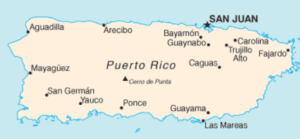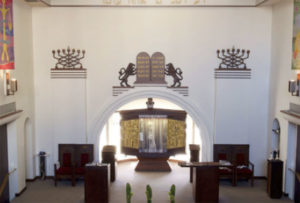 The Jewish community of Puerto Rico dates back to the days of the Spanish Inquisition when it was discovered by Columbus in 1493. However, Puerto Rico did not attract a significant Jewish population until the 20th century. Although Conversos came to Puerto Rico with the conquistadors, since Spain barred Jews/Conversos and even convened courts of Inquisition in Puerto Rico, the Conversos settled in remote mountainous regions far from the eye of the Church. When Jews or Crypto-Jews did settle in Puerto Rico, they often adopted Spanish-Christian names to hide their identities. It was not until Spain ceded Puerto Rico to the United States in the Spanish-American War of 1898 that the island became more hospitable to a viable Jewish community.
The Jewish community of Puerto Rico dates back to the days of the Spanish Inquisition when it was discovered by Columbus in 1493. However, Puerto Rico did not attract a significant Jewish population until the 20th century. Although Conversos came to Puerto Rico with the conquistadors, since Spain barred Jews/Conversos and even convened courts of Inquisition in Puerto Rico, the Conversos settled in remote mountainous regions far from the eye of the Church. When Jews or Crypto-Jews did settle in Puerto Rico, they often adopted Spanish-Christian names to hide their identities. It was not until Spain ceded Puerto Rico to the United States in the Spanish-American War of 1898 that the island became more hospitable to a viable Jewish community.
 Because of the American quota system restricting immigration after World War I, Jews came to Puerto Rico while waiting to enter the mainland, and often remained. The community increased substantially during World War II: 400 Jewish soldiers lived in military bases on the island, and the first community Seder was held in 1942.
Because of the American quota system restricting immigration after World War I, Jews came to Puerto Rico while waiting to enter the mainland, and often remained. The community increased substantially during World War II: 400 Jewish soldiers lived in military bases on the island, and the first community Seder was held in 1942.
A large group of Jewish refugees fleeing Nazi occupied Europearrived in the 1930s-40s. The majority settled in the island’s capital, San Juan, where in 1942 they established the first Jewish Community Centre of Puerto Rico. This centre promoted social services, entertainment and mutual help.
Another influx of Jewish immigrants occurred in the 1950s, following the success of the Cuban Revolution led by Fidel Castro, in 1959. Almost all of Cuba’s 15,000 Jews went into exile, many of them fleeing to Puerto Rico.
 The military junta in Argentina between 1976 and 1983 brought yet another wave of Jews escaping repression. In the mid-1980s, about 200 Israelis participated in an agricultural development program occupying 2,000 acres in the mountainous Santa Isabel region, introducing irrigation technology and developing the island’s first commercial mango plantation and vegetable farm. Now called Gan Eden and run by agronomist Yoav Cohen, the farm sells papayas, cucumbers, squash and peppers to distributors in Miami, and indigenous Kitt mangoes to Europe. About 20 Israelis in business and agriculture remain in Puerto Rico.
The military junta in Argentina between 1976 and 1983 brought yet another wave of Jews escaping repression. In the mid-1980s, about 200 Israelis participated in an agricultural development program occupying 2,000 acres in the mountainous Santa Isabel region, introducing irrigation technology and developing the island’s first commercial mango plantation and vegetable farm. Now called Gan Eden and run by agronomist Yoav Cohen, the farm sells papayas, cucumbers, squash and peppers to distributors in Miami, and indigenous Kitt mangoes to Europe. About 20 Israelis in business and agriculture remain in Puerto Rico.
The island’s first synagogue, Shaare Zedeck was established in 1953. Two years later, the first rabbi was hired and a Hebrew School was founded. The interior of the synagogue was refurbished in 1984, and now can accommodate over 600 people.
 Temple Beth Shalom, was established in 1967. Temple Beth Shalom is probably the only synagogue in the world where Friday night services are conducted in a mix of four languages: Hebrew, English, Spanish and Ladino, a dialect once spoken by Sephardic Jews. About a quarter of its members are Puerto Rican-born converts, many claiming Converso heritage, who are now re-discovering their roots.
Temple Beth Shalom, was established in 1967. Temple Beth Shalom is probably the only synagogue in the world where Friday night services are conducted in a mix of four languages: Hebrew, English, Spanish and Ladino, a dialect once spoken by Sephardic Jews. About a quarter of its members are Puerto Rican-born converts, many claiming Converso heritage, who are now re-discovering their roots.
Ever since the last large influx of Jews from South America in the 1990s, the numbers have been dwindling. But over the past year or so, the Puerto Rican Jewish community has been able to recoup a small share of its losses through new tax incentives designed to lure wealthy Jewish stockbrokers and hedge fund owners from New York to its shores. These tax breaks are aimed at reinvigorating the ailing economy.
Most of Puerto Rico’s Jews live in the San Juan area, in the Isla Verde, Condado and Miramar neighborhoods. Puerto Rico is home to a Jewish population of about 2,000, and boasts several synagogues, and a Jewish Welcome Centre. The Sha’are Tzedek synagogue runs a school attended by more than one hundred children, and Hebrew school classes are held in the Jewish community center in San Juan. Most of the new generation maintain a strong sense of Jewish identity and rarely intermarry.